Sociological Analysis of Hierarchy and Power in Australian Healthcare
VerifiedAdded on 2021/05/31
|11
|2976
|87
Essay
AI Summary
This essay provides a comprehensive analysis of hierarchy and power dynamics within the Australian healthcare system. It explores the influence of these factors on health practitioners, service delivery, and the broader healthcare landscape. The essay delves into various sociological theories and concepts, including conflict theory, social learning theory, functionalist perspective, social exchange theory, and critical theory, to explain the impacts of power and hierarchy. It examines the roles of different levels of the healthcare hierarchy, from hospital administrators to nurses, and their responsibilities. The essay also discusses the implications of power imbalances, such as discrimination and abuse of authority, on patient care and the overall effectiveness of the healthcare system. Furthermore, it highlights the importance of social factors, such as access to healthcare, the role of Medicare, and the application of the biomedical model in understanding health outcomes in Australia. The essay concludes by emphasizing the need for balanced power distribution and improved social status for healthcare professionals to ensure the well-being of both practitioners and the society.

Running head: HIERARCHY AND POWER IN AUSTRALIAN HEALTHCARE SYSTEM 1
Hierarchy and Power in Australian Healthcare System
Student’s Name
Institutional Affiliation
Hierarchy and Power in Australian Healthcare System
Student’s Name
Institutional Affiliation
Paraphrase This Document
Need a fresh take? Get an instant paraphrase of this document with our AI Paraphraser
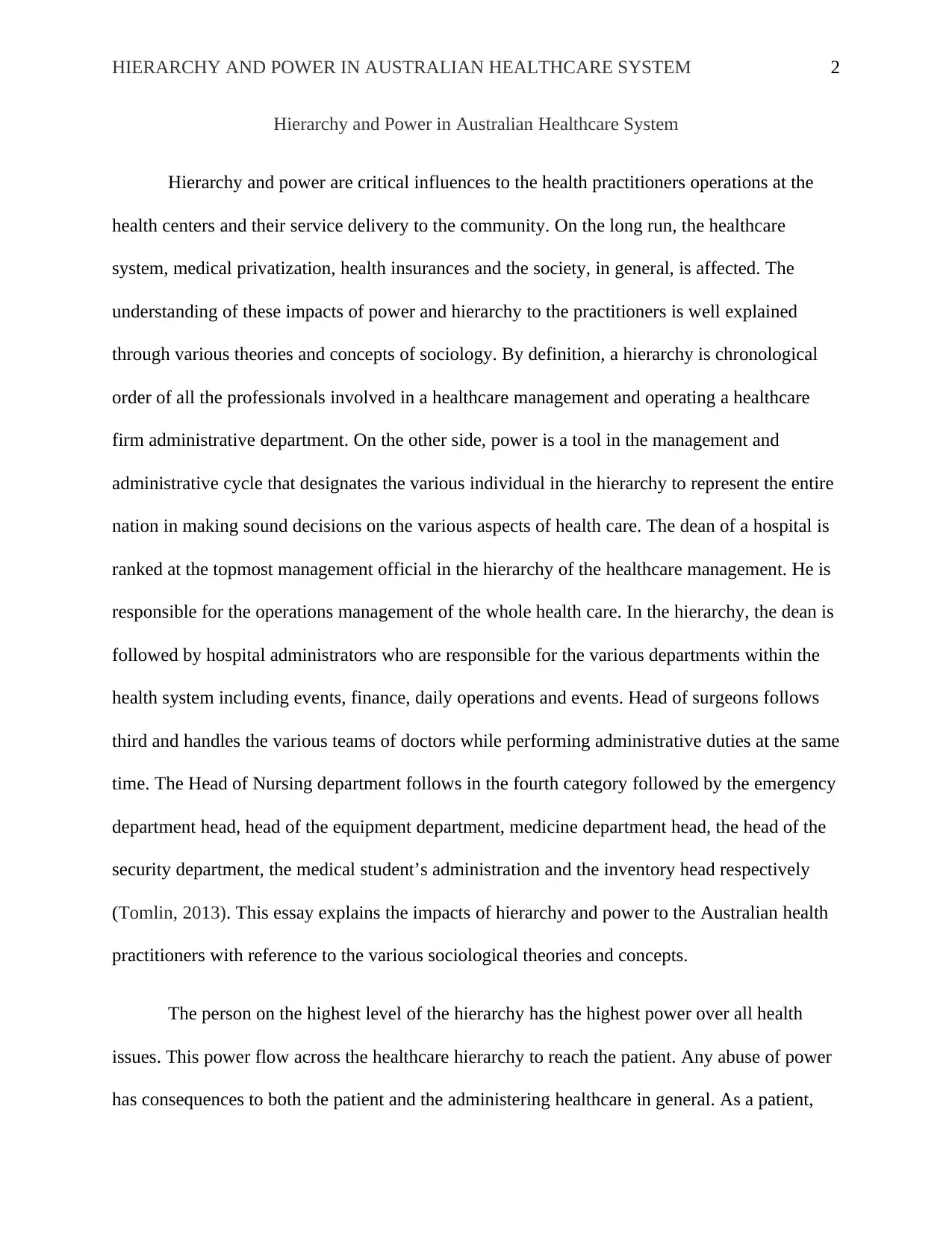
HIERARCHY AND POWER IN AUSTRALIAN HEALTHCARE SYSTEM 2
Hierarchy and Power in Australian Healthcare System
Hierarchy and power are critical influences to the health practitioners operations at the
health centers and their service delivery to the community. On the long run, the healthcare
system, medical privatization, health insurances and the society, in general, is affected. The
understanding of these impacts of power and hierarchy to the practitioners is well explained
through various theories and concepts of sociology. By definition, a hierarchy is chronological
order of all the professionals involved in a healthcare management and operating a healthcare
firm administrative department. On the other side, power is a tool in the management and
administrative cycle that designates the various individual in the hierarchy to represent the entire
nation in making sound decisions on the various aspects of health care. The dean of a hospital is
ranked at the topmost management official in the hierarchy of the healthcare management. He is
responsible for the operations management of the whole health care. In the hierarchy, the dean is
followed by hospital administrators who are responsible for the various departments within the
health system including events, finance, daily operations and events. Head of surgeons follows
third and handles the various teams of doctors while performing administrative duties at the same
time. The Head of Nursing department follows in the fourth category followed by the emergency
department head, head of the equipment department, medicine department head, the head of the
security department, the medical student’s administration and the inventory head respectively
(Tomlin, 2013). This essay explains the impacts of hierarchy and power to the Australian health
practitioners with reference to the various sociological theories and concepts.
The person on the highest level of the hierarchy has the highest power over all health
issues. This power flow across the healthcare hierarchy to reach the patient. Any abuse of power
has consequences to both the patient and the administering healthcare in general. As a patient,
Hierarchy and Power in Australian Healthcare System
Hierarchy and power are critical influences to the health practitioners operations at the
health centers and their service delivery to the community. On the long run, the healthcare
system, medical privatization, health insurances and the society, in general, is affected. The
understanding of these impacts of power and hierarchy to the practitioners is well explained
through various theories and concepts of sociology. By definition, a hierarchy is chronological
order of all the professionals involved in a healthcare management and operating a healthcare
firm administrative department. On the other side, power is a tool in the management and
administrative cycle that designates the various individual in the hierarchy to represent the entire
nation in making sound decisions on the various aspects of health care. The dean of a hospital is
ranked at the topmost management official in the hierarchy of the healthcare management. He is
responsible for the operations management of the whole health care. In the hierarchy, the dean is
followed by hospital administrators who are responsible for the various departments within the
health system including events, finance, daily operations and events. Head of surgeons follows
third and handles the various teams of doctors while performing administrative duties at the same
time. The Head of Nursing department follows in the fourth category followed by the emergency
department head, head of the equipment department, medicine department head, the head of the
security department, the medical student’s administration and the inventory head respectively
(Tomlin, 2013). This essay explains the impacts of hierarchy and power to the Australian health
practitioners with reference to the various sociological theories and concepts.
The person on the highest level of the hierarchy has the highest power over all health
issues. This power flow across the healthcare hierarchy to reach the patient. Any abuse of power
has consequences to both the patient and the administering healthcare in general. As a patient,
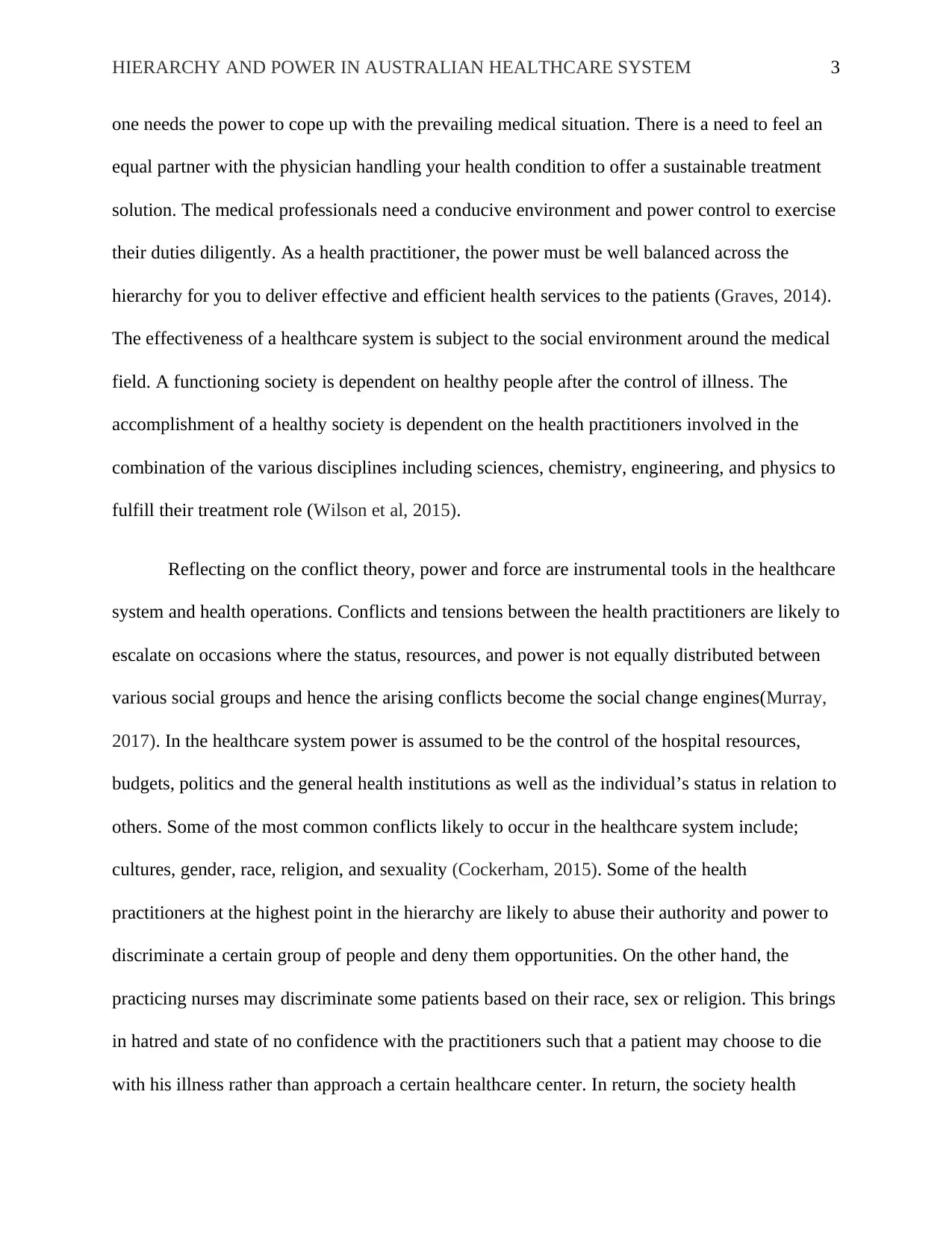
HIERARCHY AND POWER IN AUSTRALIAN HEALTHCARE SYSTEM 3
one needs the power to cope up with the prevailing medical situation. There is a need to feel an
equal partner with the physician handling your health condition to offer a sustainable treatment
solution. The medical professionals need a conducive environment and power control to exercise
their duties diligently. As a health practitioner, the power must be well balanced across the
hierarchy for you to deliver effective and efficient health services to the patients (Graves, 2014).
The effectiveness of a healthcare system is subject to the social environment around the medical
field. A functioning society is dependent on healthy people after the control of illness. The
accomplishment of a healthy society is dependent on the health practitioners involved in the
combination of the various disciplines including sciences, chemistry, engineering, and physics to
fulfill their treatment role (Wilson et al, 2015).
Reflecting on the conflict theory, power and force are instrumental tools in the healthcare
system and health operations. Conflicts and tensions between the health practitioners are likely to
escalate on occasions where the status, resources, and power is not equally distributed between
various social groups and hence the arising conflicts become the social change engines(Murray,
2017). In the healthcare system power is assumed to be the control of the hospital resources,
budgets, politics and the general health institutions as well as the individual’s status in relation to
others. Some of the most common conflicts likely to occur in the healthcare system include;
cultures, gender, race, religion, and sexuality (Cockerham, 2015). Some of the health
practitioners at the highest point in the hierarchy are likely to abuse their authority and power to
discriminate a certain group of people and deny them opportunities. On the other hand, the
practicing nurses may discriminate some patients based on their race, sex or religion. This brings
in hatred and state of no confidence with the practitioners such that a patient may choose to die
with his illness rather than approach a certain healthcare center. In return, the society health
one needs the power to cope up with the prevailing medical situation. There is a need to feel an
equal partner with the physician handling your health condition to offer a sustainable treatment
solution. The medical professionals need a conducive environment and power control to exercise
their duties diligently. As a health practitioner, the power must be well balanced across the
hierarchy for you to deliver effective and efficient health services to the patients (Graves, 2014).
The effectiveness of a healthcare system is subject to the social environment around the medical
field. A functioning society is dependent on healthy people after the control of illness. The
accomplishment of a healthy society is dependent on the health practitioners involved in the
combination of the various disciplines including sciences, chemistry, engineering, and physics to
fulfill their treatment role (Wilson et al, 2015).
Reflecting on the conflict theory, power and force are instrumental tools in the healthcare
system and health operations. Conflicts and tensions between the health practitioners are likely to
escalate on occasions where the status, resources, and power is not equally distributed between
various social groups and hence the arising conflicts become the social change engines(Murray,
2017). In the healthcare system power is assumed to be the control of the hospital resources,
budgets, politics and the general health institutions as well as the individual’s status in relation to
others. Some of the most common conflicts likely to occur in the healthcare system include;
cultures, gender, race, religion, and sexuality (Cockerham, 2015). Some of the health
practitioners at the highest point in the hierarchy are likely to abuse their authority and power to
discriminate a certain group of people and deny them opportunities. On the other hand, the
practicing nurses may discriminate some patients based on their race, sex or religion. This brings
in hatred and state of no confidence with the practitioners such that a patient may choose to die
with his illness rather than approach a certain healthcare center. In return, the society health
⊘ This is a preview!⊘
Do you want full access?
Subscribe today to unlock all pages.

Trusted by 1+ million students worldwide
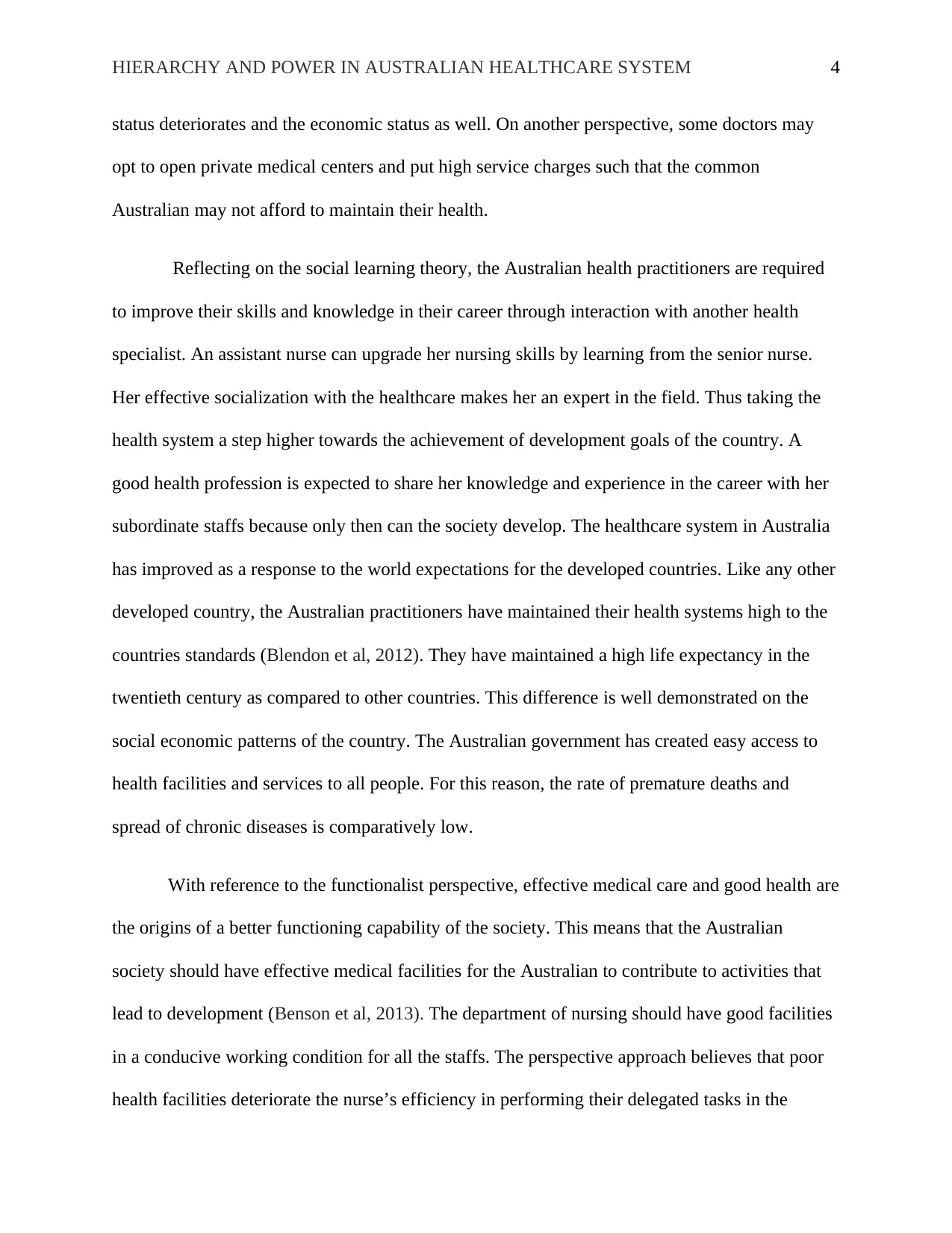
HIERARCHY AND POWER IN AUSTRALIAN HEALTHCARE SYSTEM 4
status deteriorates and the economic status as well. On another perspective, some doctors may
opt to open private medical centers and put high service charges such that the common
Australian may not afford to maintain their health.
Reflecting on the social learning theory, the Australian health practitioners are required
to improve their skills and knowledge in their career through interaction with another health
specialist. An assistant nurse can upgrade her nursing skills by learning from the senior nurse.
Her effective socialization with the healthcare makes her an expert in the field. Thus taking the
health system a step higher towards the achievement of development goals of the country. A
good health profession is expected to share her knowledge and experience in the career with her
subordinate staffs because only then can the society develop. The healthcare system in Australia
has improved as a response to the world expectations for the developed countries. Like any other
developed country, the Australian practitioners have maintained their health systems high to the
countries standards (Blendon et al, 2012). They have maintained a high life expectancy in the
twentieth century as compared to other countries. This difference is well demonstrated on the
social economic patterns of the country. The Australian government has created easy access to
health facilities and services to all people. For this reason, the rate of premature deaths and
spread of chronic diseases is comparatively low.
With reference to the functionalist perspective, effective medical care and good health are
the origins of a better functioning capability of the society. This means that the Australian
society should have effective medical facilities for the Australian to contribute to activities that
lead to development (Benson et al, 2013). The department of nursing should have good facilities
in a conducive working condition for all the staffs. The perspective approach believes that poor
health facilities deteriorate the nurse’s efficiency in performing their delegated tasks in the
status deteriorates and the economic status as well. On another perspective, some doctors may
opt to open private medical centers and put high service charges such that the common
Australian may not afford to maintain their health.
Reflecting on the social learning theory, the Australian health practitioners are required
to improve their skills and knowledge in their career through interaction with another health
specialist. An assistant nurse can upgrade her nursing skills by learning from the senior nurse.
Her effective socialization with the healthcare makes her an expert in the field. Thus taking the
health system a step higher towards the achievement of development goals of the country. A
good health profession is expected to share her knowledge and experience in the career with her
subordinate staffs because only then can the society develop. The healthcare system in Australia
has improved as a response to the world expectations for the developed countries. Like any other
developed country, the Australian practitioners have maintained their health systems high to the
countries standards (Blendon et al, 2012). They have maintained a high life expectancy in the
twentieth century as compared to other countries. This difference is well demonstrated on the
social economic patterns of the country. The Australian government has created easy access to
health facilities and services to all people. For this reason, the rate of premature deaths and
spread of chronic diseases is comparatively low.
With reference to the functionalist perspective, effective medical care and good health are
the origins of a better functioning capability of the society. This means that the Australian
society should have effective medical facilities for the Australian to contribute to activities that
lead to development (Benson et al, 2013). The department of nursing should have good facilities
in a conducive working condition for all the staffs. The perspective approach believes that poor
health facilities deteriorate the nurse’s efficiency in performing their delegated tasks in the
Paraphrase This Document
Need a fresh take? Get an instant paraphrase of this document with our AI Paraphraser
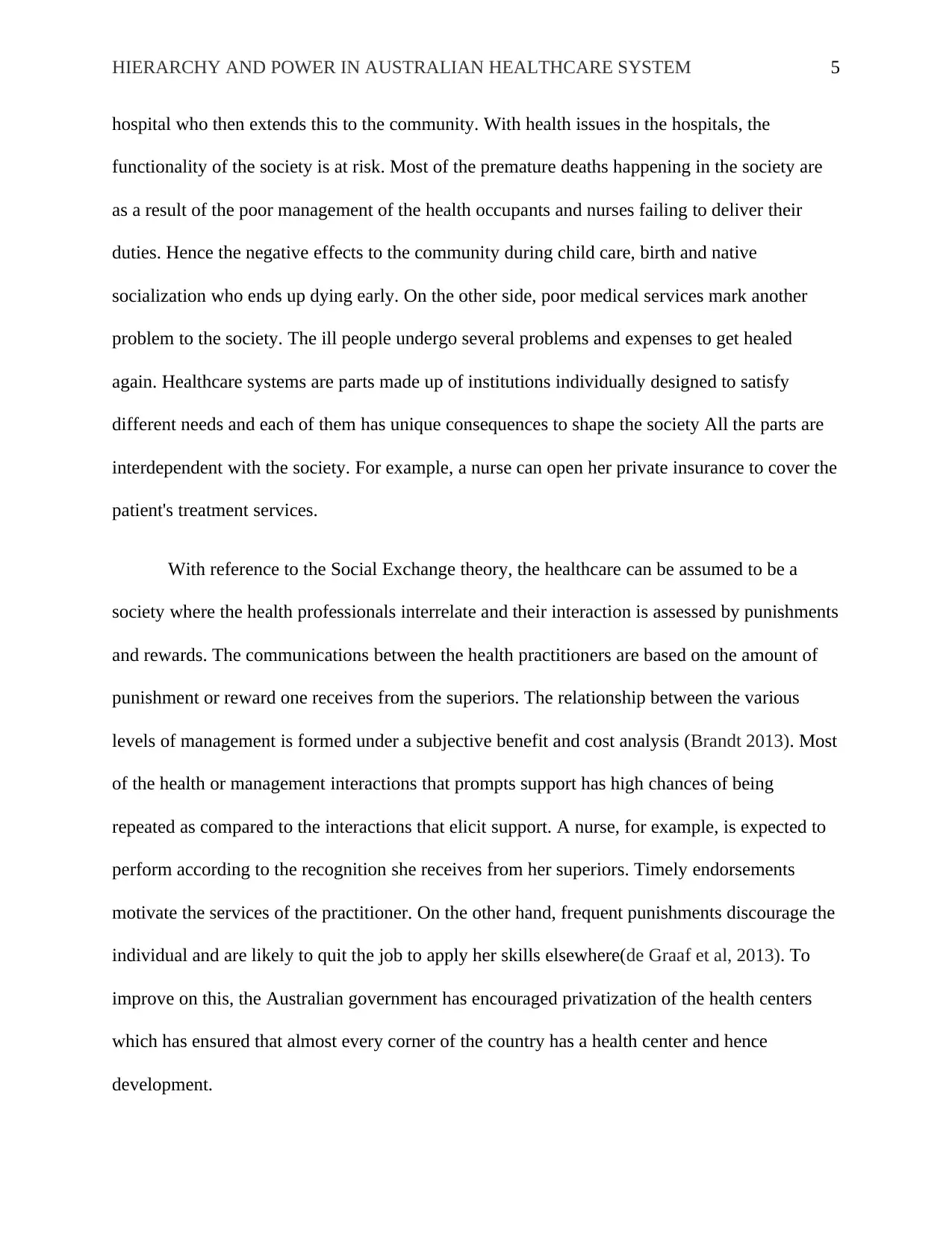
HIERARCHY AND POWER IN AUSTRALIAN HEALTHCARE SYSTEM 5
hospital who then extends this to the community. With health issues in the hospitals, the
functionality of the society is at risk. Most of the premature deaths happening in the society are
as a result of the poor management of the health occupants and nurses failing to deliver their
duties. Hence the negative effects to the community during child care, birth and native
socialization who ends up dying early. On the other side, poor medical services mark another
problem to the society. The ill people undergo several problems and expenses to get healed
again. Healthcare systems are parts made up of institutions individually designed to satisfy
different needs and each of them has unique consequences to shape the society All the parts are
interdependent with the society. For example, a nurse can open her private insurance to cover the
patient's treatment services.
With reference to the Social Exchange theory, the healthcare can be assumed to be a
society where the health professionals interrelate and their interaction is assessed by punishments
and rewards. The communications between the health practitioners are based on the amount of
punishment or reward one receives from the superiors. The relationship between the various
levels of management is formed under a subjective benefit and cost analysis (Brandt 2013). Most
of the health or management interactions that prompts support has high chances of being
repeated as compared to the interactions that elicit support. A nurse, for example, is expected to
perform according to the recognition she receives from her superiors. Timely endorsements
motivate the services of the practitioner. On the other hand, frequent punishments discourage the
individual and are likely to quit the job to apply her skills elsewhere(de Graaf et al, 2013). To
improve on this, the Australian government has encouraged privatization of the health centers
which has ensured that almost every corner of the country has a health center and hence
development.
hospital who then extends this to the community. With health issues in the hospitals, the
functionality of the society is at risk. Most of the premature deaths happening in the society are
as a result of the poor management of the health occupants and nurses failing to deliver their
duties. Hence the negative effects to the community during child care, birth and native
socialization who ends up dying early. On the other side, poor medical services mark another
problem to the society. The ill people undergo several problems and expenses to get healed
again. Healthcare systems are parts made up of institutions individually designed to satisfy
different needs and each of them has unique consequences to shape the society All the parts are
interdependent with the society. For example, a nurse can open her private insurance to cover the
patient's treatment services.
With reference to the Social Exchange theory, the healthcare can be assumed to be a
society where the health professionals interrelate and their interaction is assessed by punishments
and rewards. The communications between the health practitioners are based on the amount of
punishment or reward one receives from the superiors. The relationship between the various
levels of management is formed under a subjective benefit and cost analysis (Brandt 2013). Most
of the health or management interactions that prompts support has high chances of being
repeated as compared to the interactions that elicit support. A nurse, for example, is expected to
perform according to the recognition she receives from her superiors. Timely endorsements
motivate the services of the practitioner. On the other hand, frequent punishments discourage the
individual and are likely to quit the job to apply her skills elsewhere(de Graaf et al, 2013). To
improve on this, the Australian government has encouraged privatization of the health centers
which has ensured that almost every corner of the country has a health center and hence
development.

HIERARCHY AND POWER IN AUSTRALIAN HEALTHCARE SYSTEM 6
With reference to the critical theory, the health officials have outlined systems standards
to be followed by the health practitioners during their practice. This goes beyond the social life,
revealing all the assumptions that make up the society and how it works. The nurses are ordered
to adhere to countries medical standard and this has led a long way in fostering the current
transformation in their health standards (Willis, 2016). The health care system in Australia
provides an open access to several services whose main source of funds is the government.
Having been introduced on 1984, the Medicare offers subsidies and free treatment services in all
public hospitals. For this reason, the Medicare is used to describe health care system in Australia
through its precise access to medical care and hospitals (Duckett, 2015). It has strong health
indicators as shown by her long life expectancy which is ranked as the third longest globally.
Unlike other countries, Australian Health Care has well managed some of the major health
concerns affecting the developed countries including mental illness, high levels of obesity and
chronic diseases. The Australian budget spent on health care goes up to nine percent of the
national GDP after OECD and United States (Böhm et al, 2012). As a country, Australia has
expressed a wide gap between the Indigenous people’s health indicators and that of the non-
indigenous Australians. The Australians are governed by a federal government system with six
States, a commonwealth government, and two territories as well. The health department is kept
under the State's responsibility while the greatest revenue-raising powers are left to the
Commonwealth Government. The healthcare system of Australia thus has a complicated share of
roles and responsibilities in various levels of the government. It is partly funded by the private
sectors although its main source of funding is the general taxation (Weiss, 2017). While the
government provides about 67 percent of the whole expenditure, the pocket payments provide
about 17 percent. The policy-making role is dominated by the Commonwealth.
With reference to the critical theory, the health officials have outlined systems standards
to be followed by the health practitioners during their practice. This goes beyond the social life,
revealing all the assumptions that make up the society and how it works. The nurses are ordered
to adhere to countries medical standard and this has led a long way in fostering the current
transformation in their health standards (Willis, 2016). The health care system in Australia
provides an open access to several services whose main source of funds is the government.
Having been introduced on 1984, the Medicare offers subsidies and free treatment services in all
public hospitals. For this reason, the Medicare is used to describe health care system in Australia
through its precise access to medical care and hospitals (Duckett, 2015). It has strong health
indicators as shown by her long life expectancy which is ranked as the third longest globally.
Unlike other countries, Australian Health Care has well managed some of the major health
concerns affecting the developed countries including mental illness, high levels of obesity and
chronic diseases. The Australian budget spent on health care goes up to nine percent of the
national GDP after OECD and United States (Böhm et al, 2012). As a country, Australia has
expressed a wide gap between the Indigenous people’s health indicators and that of the non-
indigenous Australians. The Australians are governed by a federal government system with six
States, a commonwealth government, and two territories as well. The health department is kept
under the State's responsibility while the greatest revenue-raising powers are left to the
Commonwealth Government. The healthcare system of Australia thus has a complicated share of
roles and responsibilities in various levels of the government. It is partly funded by the private
sectors although its main source of funding is the general taxation (Weiss, 2017). While the
government provides about 67 percent of the whole expenditure, the pocket payments provide
about 17 percent. The policy-making role is dominated by the Commonwealth.
⊘ This is a preview!⊘
Do you want full access?
Subscribe today to unlock all pages.

Trusted by 1+ million students worldwide
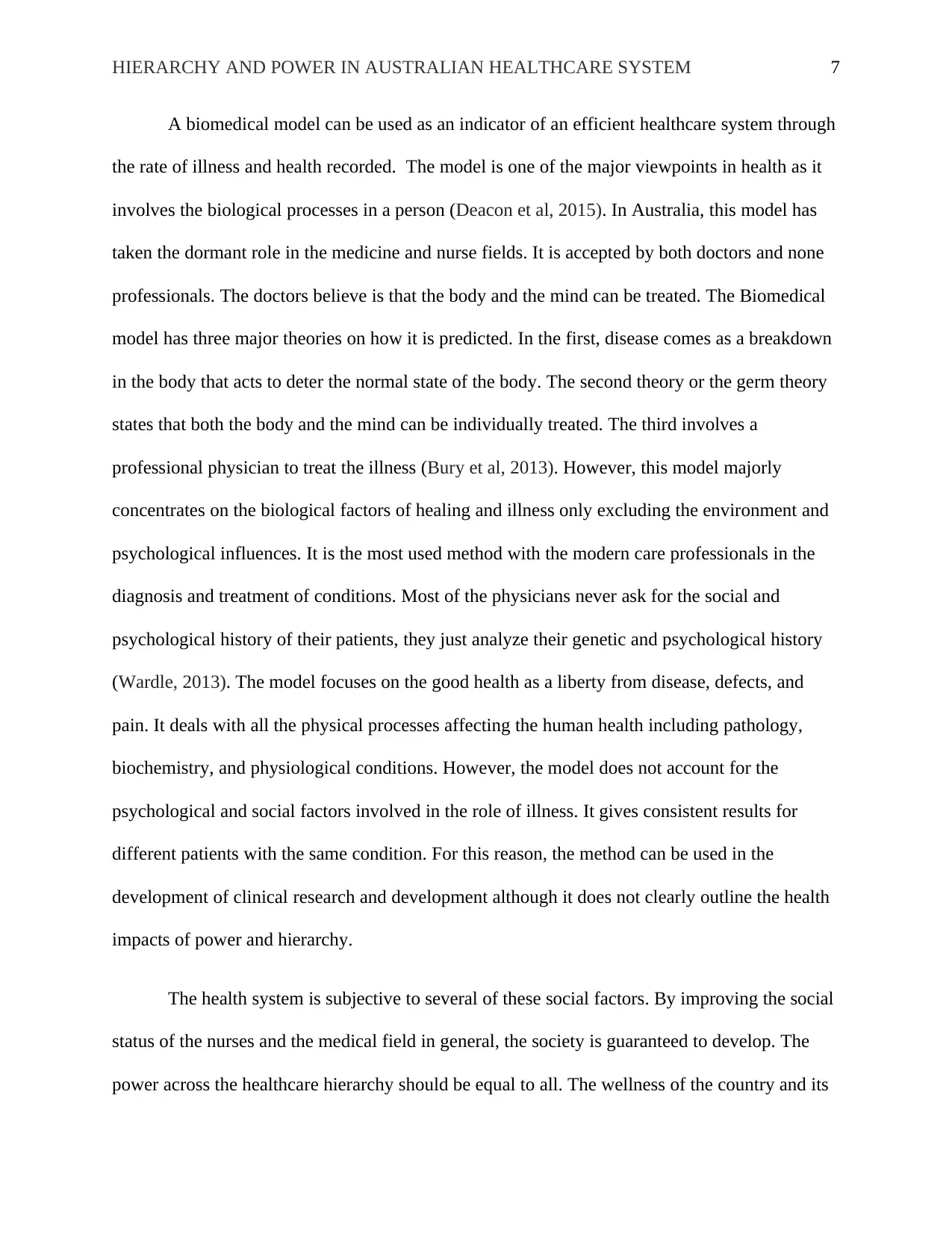
HIERARCHY AND POWER IN AUSTRALIAN HEALTHCARE SYSTEM 7
A biomedical model can be used as an indicator of an efficient healthcare system through
the rate of illness and health recorded. The model is one of the major viewpoints in health as it
involves the biological processes in a person (Deacon et al, 2015). In Australia, this model has
taken the dormant role in the medicine and nurse fields. It is accepted by both doctors and none
professionals. The doctors believe is that the body and the mind can be treated. The Biomedical
model has three major theories on how it is predicted. In the first, disease comes as a breakdown
in the body that acts to deter the normal state of the body. The second theory or the germ theory
states that both the body and the mind can be individually treated. The third involves a
professional physician to treat the illness (Bury et al, 2013). However, this model majorly
concentrates on the biological factors of healing and illness only excluding the environment and
psychological influences. It is the most used method with the modern care professionals in the
diagnosis and treatment of conditions. Most of the physicians never ask for the social and
psychological history of their patients, they just analyze their genetic and psychological history
(Wardle, 2013). The model focuses on the good health as a liberty from disease, defects, and
pain. It deals with all the physical processes affecting the human health including pathology,
biochemistry, and physiological conditions. However, the model does not account for the
psychological and social factors involved in the role of illness. It gives consistent results for
different patients with the same condition. For this reason, the method can be used in the
development of clinical research and development although it does not clearly outline the health
impacts of power and hierarchy.
The health system is subjective to several of these social factors. By improving the social
status of the nurses and the medical field in general, the society is guaranteed to develop. The
power across the healthcare hierarchy should be equal to all. The wellness of the country and its
A biomedical model can be used as an indicator of an efficient healthcare system through
the rate of illness and health recorded. The model is one of the major viewpoints in health as it
involves the biological processes in a person (Deacon et al, 2015). In Australia, this model has
taken the dormant role in the medicine and nurse fields. It is accepted by both doctors and none
professionals. The doctors believe is that the body and the mind can be treated. The Biomedical
model has three major theories on how it is predicted. In the first, disease comes as a breakdown
in the body that acts to deter the normal state of the body. The second theory or the germ theory
states that both the body and the mind can be individually treated. The third involves a
professional physician to treat the illness (Bury et al, 2013). However, this model majorly
concentrates on the biological factors of healing and illness only excluding the environment and
psychological influences. It is the most used method with the modern care professionals in the
diagnosis and treatment of conditions. Most of the physicians never ask for the social and
psychological history of their patients, they just analyze their genetic and psychological history
(Wardle, 2013). The model focuses on the good health as a liberty from disease, defects, and
pain. It deals with all the physical processes affecting the human health including pathology,
biochemistry, and physiological conditions. However, the model does not account for the
psychological and social factors involved in the role of illness. It gives consistent results for
different patients with the same condition. For this reason, the method can be used in the
development of clinical research and development although it does not clearly outline the health
impacts of power and hierarchy.
The health system is subjective to several of these social factors. By improving the social
status of the nurses and the medical field in general, the society is guaranteed to develop. The
power across the healthcare hierarchy should be equal to all. The wellness of the country and its
Paraphrase This Document
Need a fresh take? Get an instant paraphrase of this document with our AI Paraphraser
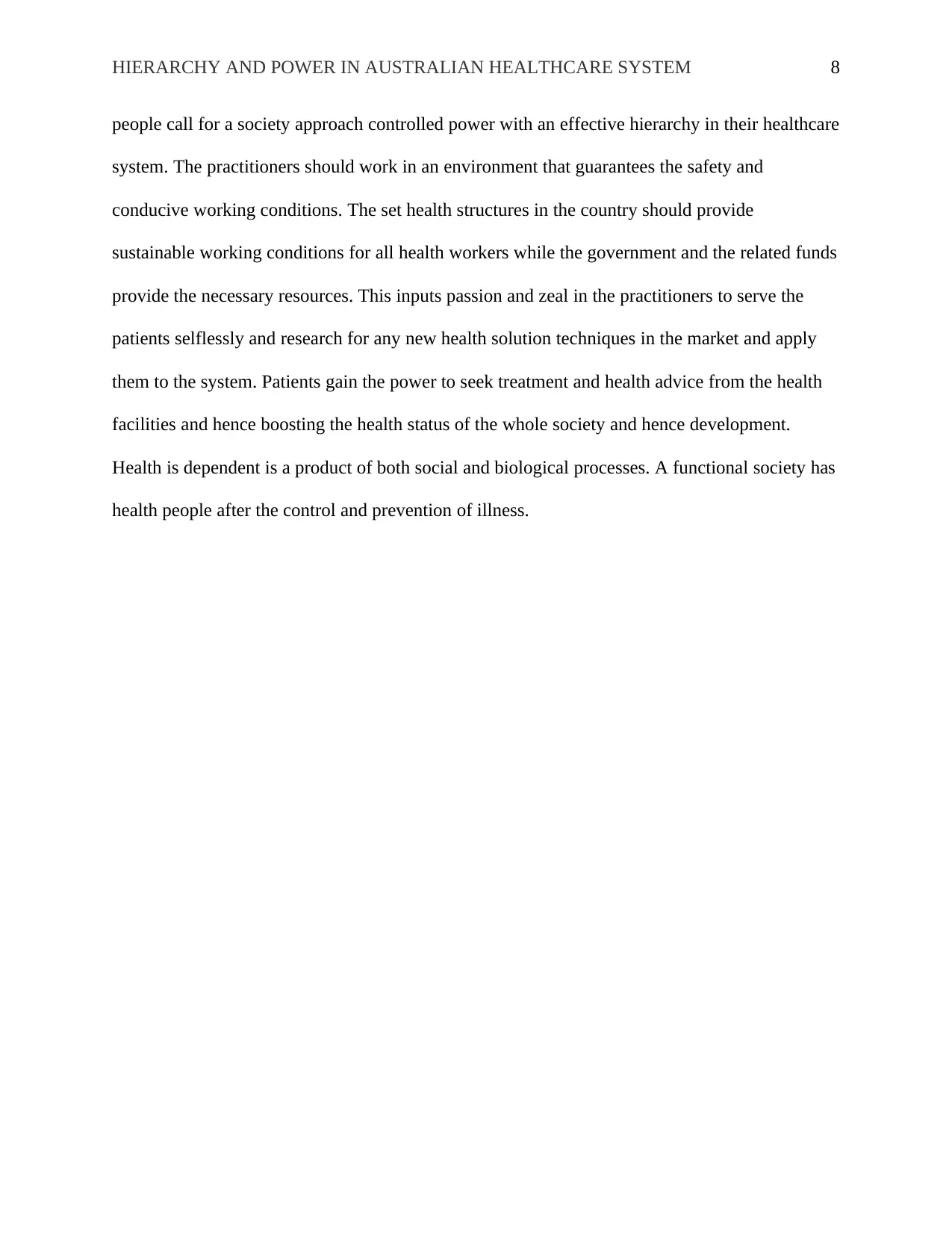
HIERARCHY AND POWER IN AUSTRALIAN HEALTHCARE SYSTEM 8
people call for a society approach controlled power with an effective hierarchy in their healthcare
system. The practitioners should work in an environment that guarantees the safety and
conducive working conditions. The set health structures in the country should provide
sustainable working conditions for all health workers while the government and the related funds
provide the necessary resources. This inputs passion and zeal in the practitioners to serve the
patients selflessly and research for any new health solution techniques in the market and apply
them to the system. Patients gain the power to seek treatment and health advice from the health
facilities and hence boosting the health status of the whole society and hence development.
Health is dependent is a product of both social and biological processes. A functional society has
health people after the control and prevention of illness.
people call for a society approach controlled power with an effective hierarchy in their healthcare
system. The practitioners should work in an environment that guarantees the safety and
conducive working conditions. The set health structures in the country should provide
sustainable working conditions for all health workers while the government and the related funds
provide the necessary resources. This inputs passion and zeal in the practitioners to serve the
patients selflessly and research for any new health solution techniques in the market and apply
them to the system. Patients gain the power to seek treatment and health advice from the health
facilities and hence boosting the health status of the whole society and hence development.
Health is dependent is a product of both social and biological processes. A functional society has
health people after the control and prevention of illness.
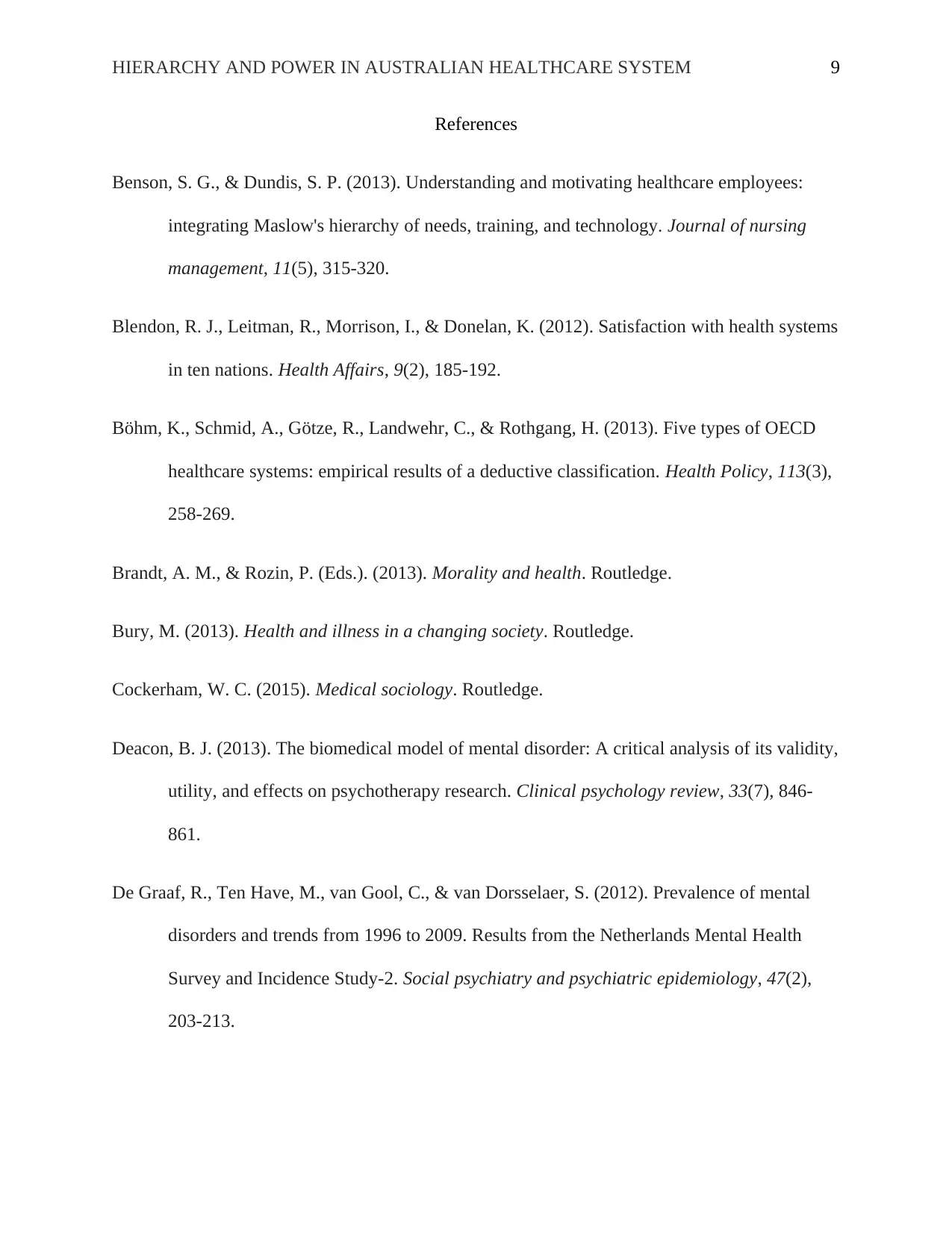
HIERARCHY AND POWER IN AUSTRALIAN HEALTHCARE SYSTEM 9
References
Benson, S. G., & Dundis, S. P. (2013). Understanding and motivating healthcare employees:
integrating Maslow's hierarchy of needs, training, and technology. Journal of nursing
management, 11(5), 315-320.
Blendon, R. J., Leitman, R., Morrison, I., & Donelan, K. (2012). Satisfaction with health systems
in ten nations. Health Affairs, 9(2), 185-192.
Böhm, K., Schmid, A., Götze, R., Landwehr, C., & Rothgang, H. (2013). Five types of OECD
healthcare systems: empirical results of a deductive classification. Health Policy, 113(3),
258-269.
Brandt, A. M., & Rozin, P. (Eds.). (2013). Morality and health. Routledge.
Bury, M. (2013). Health and illness in a changing society. Routledge.
Cockerham, W. C. (2015). Medical sociology. Routledge.
Deacon, B. J. (2013). The biomedical model of mental disorder: A critical analysis of its validity,
utility, and effects on psychotherapy research. Clinical psychology review, 33(7), 846-
861.
De Graaf, R., Ten Have, M., van Gool, C., & van Dorsselaer, S. (2012). Prevalence of mental
disorders and trends from 1996 to 2009. Results from the Netherlands Mental Health
Survey and Incidence Study-2. Social psychiatry and psychiatric epidemiology, 47(2),
203-213.
References
Benson, S. G., & Dundis, S. P. (2013). Understanding and motivating healthcare employees:
integrating Maslow's hierarchy of needs, training, and technology. Journal of nursing
management, 11(5), 315-320.
Blendon, R. J., Leitman, R., Morrison, I., & Donelan, K. (2012). Satisfaction with health systems
in ten nations. Health Affairs, 9(2), 185-192.
Böhm, K., Schmid, A., Götze, R., Landwehr, C., & Rothgang, H. (2013). Five types of OECD
healthcare systems: empirical results of a deductive classification. Health Policy, 113(3),
258-269.
Brandt, A. M., & Rozin, P. (Eds.). (2013). Morality and health. Routledge.
Bury, M. (2013). Health and illness in a changing society. Routledge.
Cockerham, W. C. (2015). Medical sociology. Routledge.
Deacon, B. J. (2013). The biomedical model of mental disorder: A critical analysis of its validity,
utility, and effects on psychotherapy research. Clinical psychology review, 33(7), 846-
861.
De Graaf, R., Ten Have, M., van Gool, C., & van Dorsselaer, S. (2012). Prevalence of mental
disorders and trends from 1996 to 2009. Results from the Netherlands Mental Health
Survey and Incidence Study-2. Social psychiatry and psychiatric epidemiology, 47(2),
203-213.
⊘ This is a preview!⊘
Do you want full access?
Subscribe today to unlock all pages.

Trusted by 1+ million students worldwide
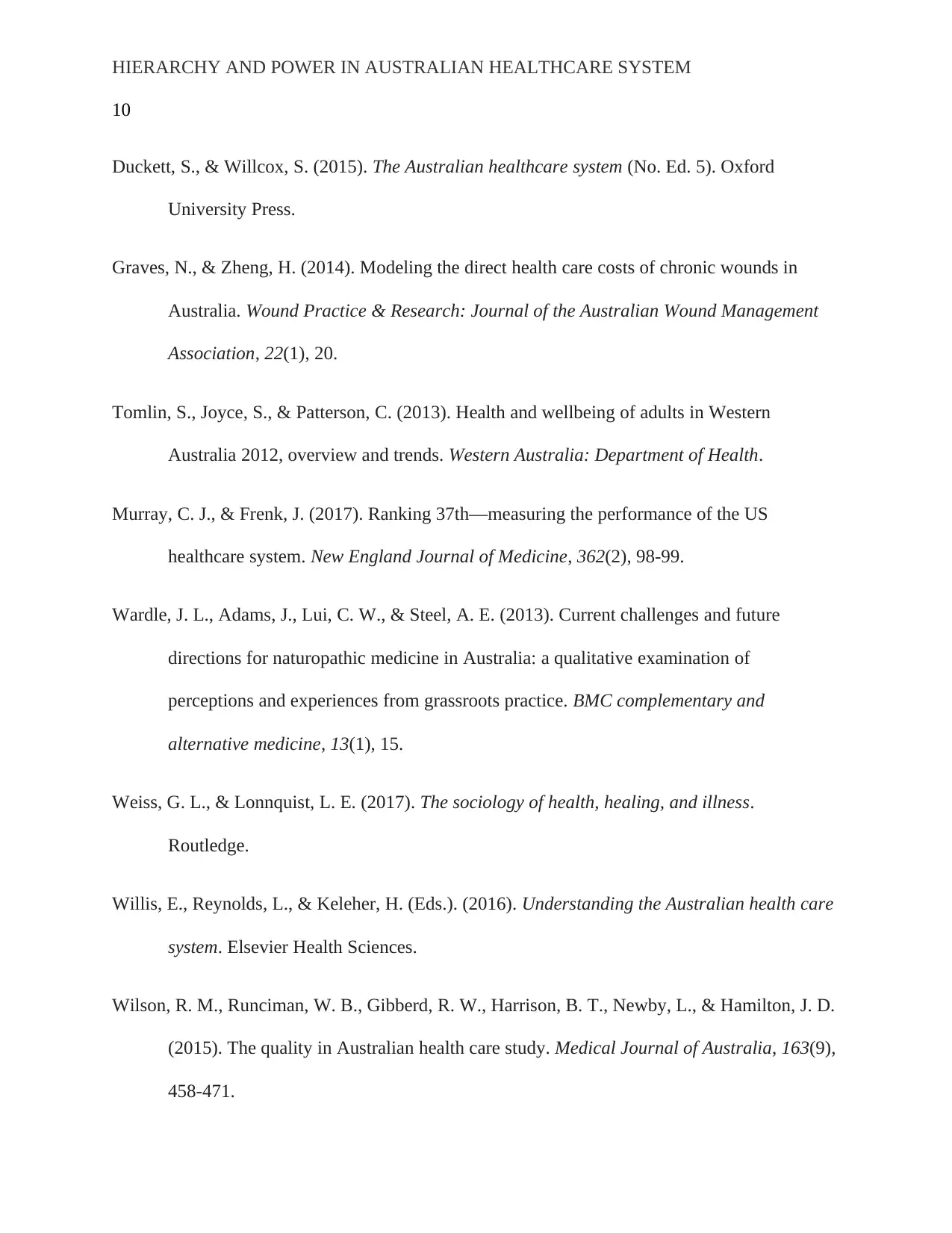
HIERARCHY AND POWER IN AUSTRALIAN HEALTHCARE SYSTEM
10
Duckett, S., & Willcox, S. (2015). The Australian healthcare system (No. Ed. 5). Oxford
University Press.
Graves, N., & Zheng, H. (2014). Modeling the direct health care costs of chronic wounds in
Australia. Wound Practice & Research: Journal of the Australian Wound Management
Association, 22(1), 20.
Tomlin, S., Joyce, S., & Patterson, C. (2013). Health and wellbeing of adults in Western
Australia 2012, overview and trends. Western Australia: Department of Health.
Murray, C. J., & Frenk, J. (2017). Ranking 37th—measuring the performance of the US
healthcare system. New England Journal of Medicine, 362(2), 98-99.
Wardle, J. L., Adams, J., Lui, C. W., & Steel, A. E. (2013). Current challenges and future
directions for naturopathic medicine in Australia: a qualitative examination of
perceptions and experiences from grassroots practice. BMC complementary and
alternative medicine, 13(1), 15.
Weiss, G. L., & Lonnquist, L. E. (2017). The sociology of health, healing, and illness.
Routledge.
Willis, E., Reynolds, L., & Keleher, H. (Eds.). (2016). Understanding the Australian health care
system. Elsevier Health Sciences.
Wilson, R. M., Runciman, W. B., Gibberd, R. W., Harrison, B. T., Newby, L., & Hamilton, J. D.
(2015). The quality in Australian health care study. Medical Journal of Australia, 163(9),
458-471.
10
Duckett, S., & Willcox, S. (2015). The Australian healthcare system (No. Ed. 5). Oxford
University Press.
Graves, N., & Zheng, H. (2014). Modeling the direct health care costs of chronic wounds in
Australia. Wound Practice & Research: Journal of the Australian Wound Management
Association, 22(1), 20.
Tomlin, S., Joyce, S., & Patterson, C. (2013). Health and wellbeing of adults in Western
Australia 2012, overview and trends. Western Australia: Department of Health.
Murray, C. J., & Frenk, J. (2017). Ranking 37th—measuring the performance of the US
healthcare system. New England Journal of Medicine, 362(2), 98-99.
Wardle, J. L., Adams, J., Lui, C. W., & Steel, A. E. (2013). Current challenges and future
directions for naturopathic medicine in Australia: a qualitative examination of
perceptions and experiences from grassroots practice. BMC complementary and
alternative medicine, 13(1), 15.
Weiss, G. L., & Lonnquist, L. E. (2017). The sociology of health, healing, and illness.
Routledge.
Willis, E., Reynolds, L., & Keleher, H. (Eds.). (2016). Understanding the Australian health care
system. Elsevier Health Sciences.
Wilson, R. M., Runciman, W. B., Gibberd, R. W., Harrison, B. T., Newby, L., & Hamilton, J. D.
(2015). The quality in Australian health care study. Medical Journal of Australia, 163(9),
458-471.
Paraphrase This Document
Need a fresh take? Get an instant paraphrase of this document with our AI Paraphraser
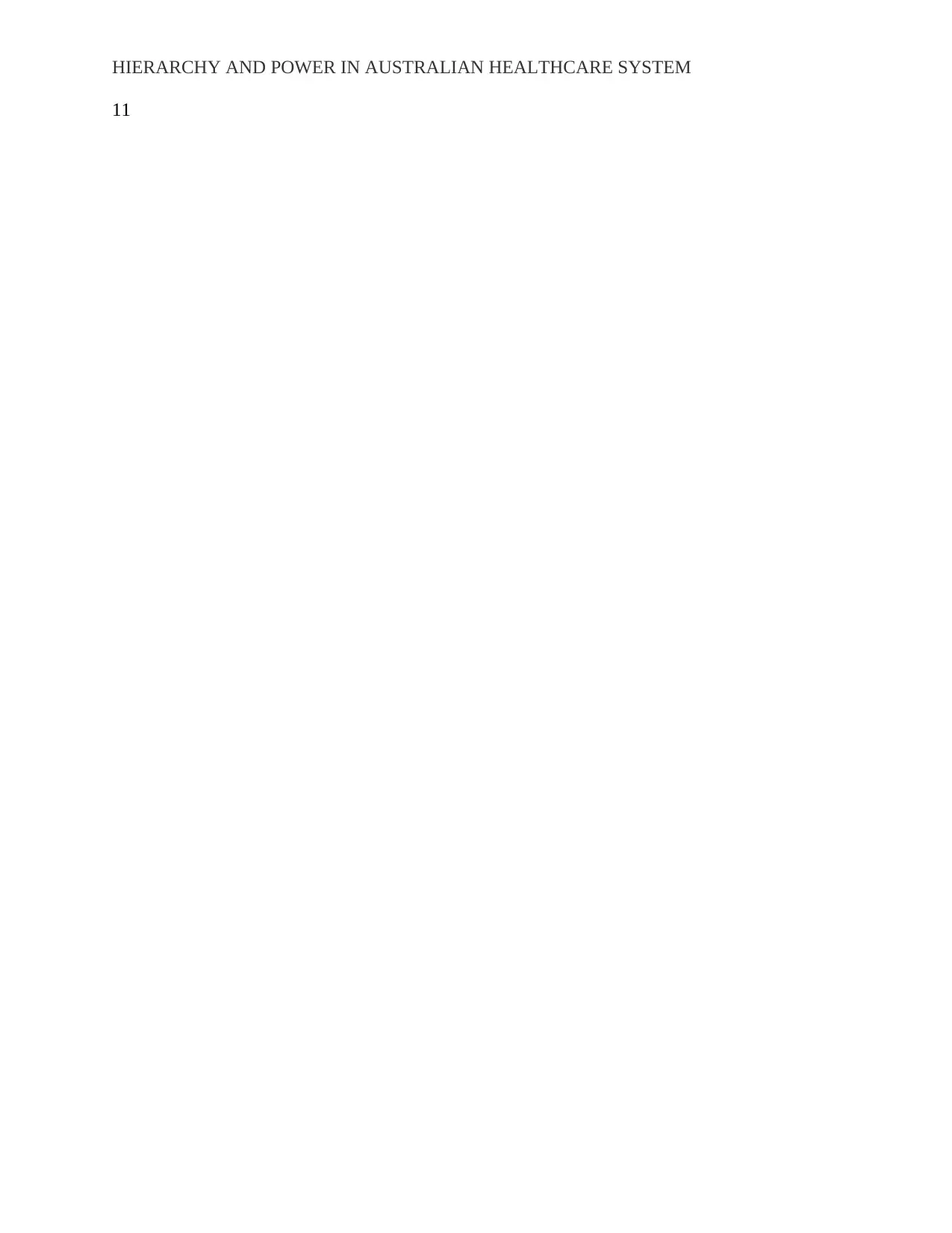
HIERARCHY AND POWER IN AUSTRALIAN HEALTHCARE SYSTEM
11
11
1 out of 11
Related Documents
Your All-in-One AI-Powered Toolkit for Academic Success.
+13062052269
info@desklib.com
Available 24*7 on WhatsApp / Email
![[object Object]](/_next/static/media/star-bottom.7253800d.svg)
Unlock your academic potential
Copyright © 2020–2025 A2Z Services. All Rights Reserved. Developed and managed by ZUCOL.


